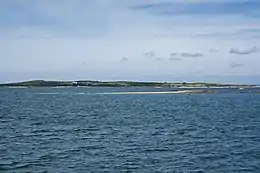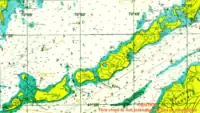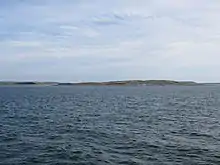Penikese Island
Penikese Island is a 75-acre (0.117 sq mi) island off the coast of Massachusetts, United States, in Buzzards Bay. It is one of the Elizabeth Islands, which make up the town of Gosnold, Massachusetts. Penikese is located near the west end of the Elizabeth island chain.
 Penikese Island from the southeast in 2005. | |
 Penikese Island  Penikese Island | |
| Geography | |
|---|---|
| Coordinates | 41°27′00″N 70°55′23″W[1] |
| Archipelago | Elizabeth Islands |
| Total islands | 1 |
| Area | .117 sq mi (0.30 km2) |
| Highest elevation | 52 ft (15.8 m) |
| Administration | |
United States | |
| State | Massachusetts |
| County | Dukes County |
| The Elizabeth Islands |
|---|
 |
| Major islands |
| Minor islands |
|

History
Penikese Island entered the historical record in 1602 AD when the English explorer Bartholomew Gosnold and some of his crew visited the island. Their visit frightened four visiting Wampanoag Indians into hiding, and the explorers stole their canoe.[2]
Originally tree covered, at some later time the tree cover was lost, and the island was later used for pasturing sheep.[3] To this day, it remains primarily grass covered.[4] Ownership changed hands several times before the island was purchased by John Anderson, a businessman, who used it for vacationing.[5]
In early 1873, Louis Agassiz, the famous Swiss-American naturalist, persuaded Anderson to give him the island and $50,000 to endow a school for natural history where students would study nature instead of books. The school opened in July 1873, initially headed by Louis Agassiz. Following his death in December, his son Alexander Agassiz ran the school. The school was closed following a fire in 1875, but some of the former students opened in 1888 the Marine Biological Laboratory, in nearby Woods Hole.[5][6][7]
In 1904, following local opposition to two previously selected sites on the mainland, the state of Massachusetts purchased the island for $25,000 to use as a leprosy hospital to isolate and treat all Massachusetts residents with the disease. When opened, the Penikese Island Leper Hospital had five patients. After being open for 16 years, it was closed in 1921 and the thirteen patients were transferred to the federal leprosy hospital in Carville, Louisiana. At the closing of the hospital, the state burnt and then dynamited the buildings, and all that remains of it are stone gate posts and a small cemetery.[8]
The island remains under the ownership of the Commonwealth of Massachusetts and is primarily a bird sanctuary. There is no permanent population on the island. A residential school for troubled boys operated on the island from 1973 until 2011.[5] and now offered environmental education experiences. There may also be visitors and researchers on island from time to time, as the island is publicly owned and is still used at times for biological research.[9][4] Beginning in 1990, the island was used as a test site for efforts to reintroduce the endangered American burying beetle, which appears to have succeeded; by 1997 the population had persisted for at least five generations since the last release.[10]
Penikese Island School
The Penikese Island School (PIS) was founded in 1973 as a non-profit 501(c)(3). PIS was a private rehabilitation school for teenage delinquent boys. The goal of the school was to teach by example, modeling responsible adult behavior in a spartan environment. Boys were exposed to life with earnest adults who enforced a code of behavior, as an alternative to incarceration. PIS aimed to provide an experience they hoped would help boys remanded to involuntary custody become productive citizens, instead of developing into adult criminals. The first student was from New Bedford and he had harpooned a policeman.
Having a school on the island is a benefit to the state and its efforts to protect endangered nesting birds, as the presence of staff on the island helps deter illegal hunters and campers.
During the mid 1990’s, the original founders of PIS were no longer in charge. New leadership continued the program to 2011, when funding from the state of Massachusetts was no longer available. In the fall of 2015, a long-term opioid-addiction treatment facility named Penikese began operation on the island. According to several newspapers, the treatment center shut down in 2017 after a lack of funding.[11]
In 2019 PIS began offering programs with a new mission focused on place-based environmental education. Penikese Island is a safe, serene, and unspoiled environment, providing the perfect setting for fostering environmental literacy and stewardship. The new mission is to provide students with access to experiential, nature-based and STEAM-focused educational programs in the island’s unique and unspoiled natural environment. The overarching goal of the current educational programming is to get students off their screens and out into nature. Programming aims to expand scientific literacy, inspire curiosity and creativity, and build appreciation and understanding of the wider world. PIS currently operates school trips during the academic year and a STEAM camp for girls and gender expansive youth during the summer.
References
- "Penikese Island". Geographic Names Information System. United States Geological Survey, United States Department of the Interior. Retrieved 2018-08-20.
- Schneider, Paul (2001). The Enduring Shore: A History of Cape Cod, Martha's Vineyard, and Nantucket (illustrated ed.). New York: Macmillan. p. 12. ISBN 0-8050-6734-5. Retrieved 18 March 2009.
- Jordan, D. S. (April 1874). "The Flora of Penikese Island". The American Naturalist. Salem, Mass.: Peabody Academy of Science. VIII (4): 13 (193). doi:10.1086/271293. Retrieved 18 March 2009.
- Laux, E. Vernon (23 May 2000). "Is It a Plane? No, It's a Bird And a Very Rare Bird Indeed". The New York Times. Retrieved 18 March 2009.
- "History: Penikese Island History: The Anderson School". Penikese Island School. Retrieved 19 October 2012.
- "The Anderson School: Opening of the Establishment on Penikese Island by Prof. Agassiz" (PDF). The New York Times. 19 July 1873. Retrieved 18 March 2009.
- Lattin, Frank H. (1895). Penikese: A Reminiscence by one of its Pupils. Albion, N.Y.: Frank Lattin. p. 43. Retrieved 18 March 2009.
- Ken, Hartnett (26 November 2005). "The tragedy of Penikese Island". The Boston Globe. Retrieved 18 March 2009.
- "General FAQ". Penikese Island School. Archived from the original on February 8, 2009. Retrieved 18 March 2009.
- Reading, Richard P.; Miller, Brian (2000). Endangered Animals: a Reference Guide to Conflicting Issues (illustrated ed.). Westport, Conn.: Greenwood Publishing Group. p. 15. ISBN 0-313-30816-0. Retrieved 18 March 2009.
- Karen Brown (November 21, 2016). "Treatment Island: Addicts Are Sent To Recover Off The Coast of Cape Cod". NEPR.net. Retrieved November 21, 2016.